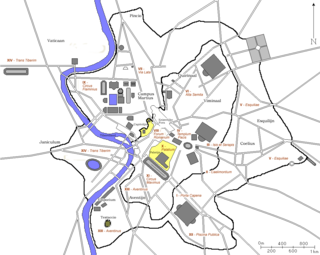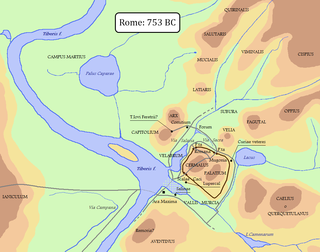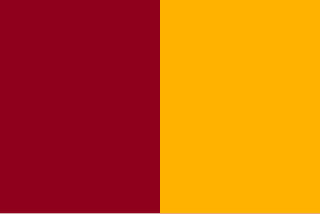
The Quirinal Hill is one of the Seven Hills of Rome, at the north-east of the city center. It is the location of the official residence of the Italian head of state, who resides in the Quirinal Palace; by metonymy "the Quirinal" has come to stand for the Italian president. The Quirinal Palace has an extension of 1.2 million sq ft (110,000 m2).

The seven hills of Rome east of the river Tiber form the geographical heart of Rome, within the walls of the city.

The Aventine Hill is one of the Seven Hills on which ancient Rome was built. It belongs to Ripa, the modern twelfth rione, or ward, of Rome.
Vatican Hill is a hill in Rome, located on the right bank of Tiber river, opposite to the traditional seven hills of Rome. The hill also gave the name to Vatican City. It is the location of St. Peter's Basilica.

The Caelian Hill is one of the famous seven hills of Rome.

The Viminal Hill is the smallest of the famous Seven Hills of Rome. A finger-shape cusp pointing toward central Rome between the Quirinal Hill to the northwest and the Esquiline Hill to the southeast, it is home to the Teatro dell'Opera and the Termini Railway Station.

The Janiculum, occasionally known as the Janiculan Hill, is a hill in western Rome, Italy. Although it is the second-tallest hill in the contemporary city of Rome, the Janiculum does not figure among the proverbial Seven Hills of Rome, being west of the Tiber and outside the boundaries of the ancient city.

St Lucia is a riverside suburb in the City of Brisbane, Queensland, Australia. The University of Queensland is the main attraction of St Lucia, with the university, and residential colleges covering a large proportion of the suburb. In the 2021 census, St Lucia had a population of 12,220 people.

West End is an inner southern suburb in the City of Brisbane, Queensland, Australia. In the 2021 census, West End had a population of 14,730 people.

Carina is an eastern suburb in the City of Brisbane, Queensland, Australia. In the 2021 census, Carina had a population of 11,678 people.

In 7 BC, Augustus divided the city of Rome into 14 administrative regions. These replaced the four regiones—or "quarters"—traditionally attributed to Servius Tullius, sixth king of Rome. They were further divided into official neighborhoods.

Camp Hill is a suburb in the City of Brisbane, Queensland, Australia. In the 2021 census, Camp Hill had a population of 12,254 people.

The Pincian Hill is a hill in the northeast quadrant of the historical centre of Rome. The hill lies to the north of the Quirinal, overlooking the Campus Martius. It was outside the original boundaries of the ancient city of Rome, and was not one of the Seven hills of Rome, but it lies within the wall built by Roman Emperor Aurelian between 270 and 273.

Spring Hill is an inner northern suburb in the City of Brisbane, Queensland, Australia. In the 2021 census, Spring Hill had a population of 6,593 people.

Lytton is an outer riverside suburb in the City of Brisbane, Queensland, Australia. In the 2021 census, Lytton had "no people or a very low population".

The Oppian Hill is the southern spur of the Esquiline Hill, one of the Seven hills of Rome, Italy. It is separated from the Cispius on the north by the valley of the Suburra, and from the Caelian Hill on the south by the valley of the Colosseum. The Oppius and the Cispius together form the Esquiline plateau just inside the line of the Servian Wall.

The Velia — or Velian Hill or Velian Ridge — is a saddle or spur stretching out from the middle of the north side of the Palatine Hill towards the Oppian Hill in Rome.

Municipio I is an administrative subdivision of the municipality of Rome, encompassing the centre of the city.

The following outline is provided as an overview of and topical guide to Rome:





















